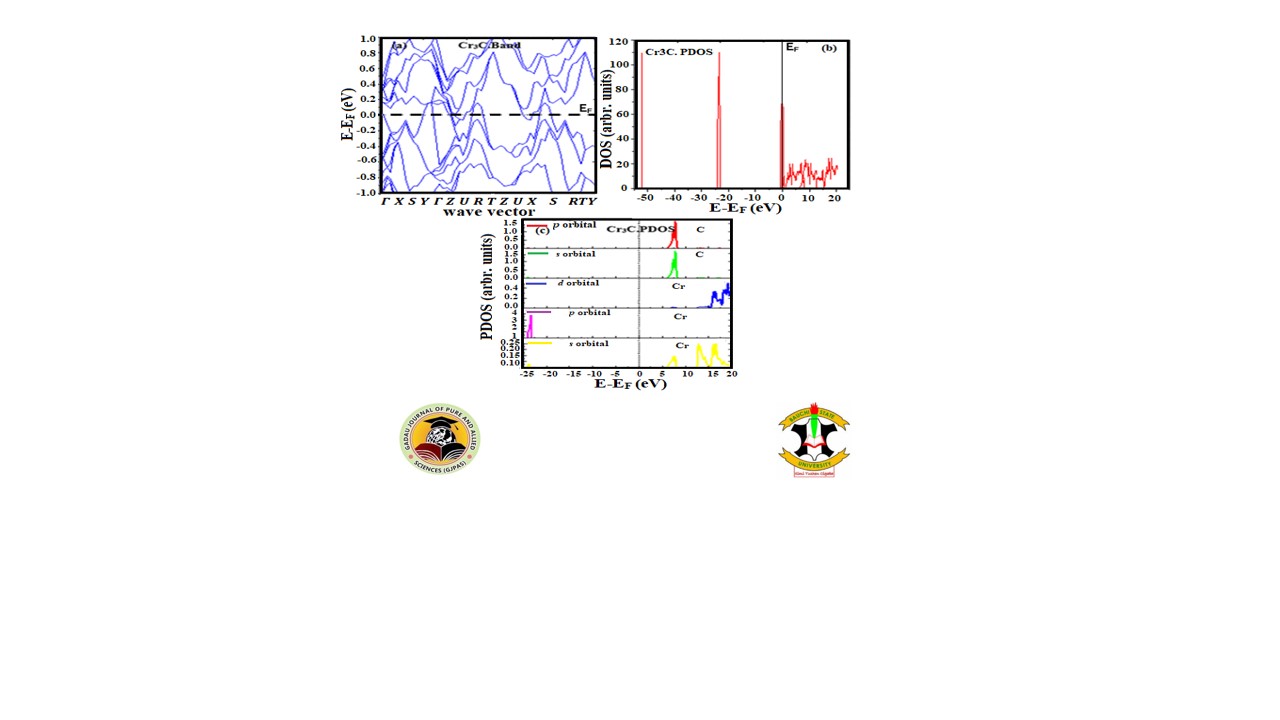Structural, electronic and optical properties of chromium carbide (Cr3C) as potential counter electrode material: a first principle study
DOI:
https://doi.org/10.54117/gjpas.v2i2.43Keywords:
Transition metal carbides (Cr3C), DFT, Counter electrode, First principle study, Optical propertiesAbstract
Transition metal carbides are recently considered to be potential substitutes to platinum counter electrode due to their low cost, high catalytic activity and good thermal stability. In this paper, we investigate the structural, electronics, and optical properties of one of the transition metal carbides (Cr3C). The structural and electronic properties were computed using the first principles approach, a generalized gradient approximation (PBE-GGA) as exchange correlation functional within density functional theory (DFT) was used for the calculations. The optimized lattice parameters of the compound were = 4.525 Ǻ, = 5.186 Ǻ, = 6.659 Ǻ and ∝ = β = γ = 90.00which are in agreement with number of theoretical and experimental results. The calculated band gap and density of state (DOS) of this compound reveals the presence of Valence Band Maximum (VBM) and Conduction Band Minimum (CBM) at different symmetry point with the intersection of several energy bands crossing the Fermi level, this interaction indicate a metallicity nature and may cost the conductive nature of the material to have sufficient electro-catalytic ability for the reduction of I3- ions in counter electrode of DSSCs. The optical properties are calculated from the spectra of dielectric function alongside with the other related optical properties like energy loss function, reflectivity, refractive index, extinction coefficient and conductivity within a continuous energy range of 0 to 16eV. The obtained results of the optical properties of this material show that the materials can be use as possible candidates for counter electrode of DSSC.
References
Abdullahi Lawal; A. Shaari, R. A. N. J. (2017). Sb2Te3 crystal a potential absorber material for broadband photodetector_ A first-principles study _ Elsevier Enhanced Reader.pdf (pp. 2302–2310). pp. 2302–2310. Results in Physics.
Ab Malik Marwan, N. A., Md Jahangir Alam, N. N., Samat, M. H., Mohyedin, M. Z., Hussain, N. H., Hassan, O. H., ... and Mohamad Taib, M. F. (2020). First-principles studies on structural, electronic and optical properties of Fe-doped NiS2 counter electrode for Dye-sensitized solar cells using DFT+ U. Scientific Research Journal, 17(2), 82-98.
Bagci, S., Yalcin, B. G., Aliabad, H. R., Duman, S., and Salmankurt, B. A. H. A. D. I. R. (2016). Structural, electronic, optical, vibrational and transport properties of CuBX 2 (X= S, Se, Te) chalcopyrites. RSC advances, 6(64), 59527-59540.
Ganguly, A., Murthy, V., and Kannoorpatti, K. (2020). Structural and electronic properties of chromium carbides and Fe-substituted chromium carbides. Materials Research Express, 7(5), 056508.
Giannozzi, P., Baroni, S., Bonini, N., Calandra, M., Car, R., Cavazzoni, C., Dabo, I. (2009). QUANTUM ESPRESSO: a modular and open-source software project for quantum simulations of materials. Journal of physics: Condensed Matter, 21 (39), 395502.
Guo, J., Liang, S., Shi, Y., Hao, C., Wang, X., and Ma, T. (2015). Transition metal selenides as efficient counter-electrode materials for dye-sensitized solar cells. Physical Chemistry Chemical Physics, 17(43), 28985-28992.
Jain, A., Ong, S. P., Hautier, G., Chen, W., Richards, W. D., Dacek, S., Cholia, S., Gunter, D., Skinner, D., Ceder, G., and Persson, K. A. (2013). The material project: A materials
Kay, A., and Grätzel, M. (1996). Low cost photovoltaic modules based on dye sensitized nanocrystalline titanium dioxide and carbon powder. Solar Energy Materials and Solar Cells, 44(1), 99-117.
Kim, J. S., Kim, B., Kim, H., and Kang, K. (2018). Recent progress on multimetal oxide catalysts for the oxygen evolution reaction. Advanced Energy Materials, 8(11), 1702774.
Kootstra, F., De Boeij, P. L., and Snijders, J. G. (2000). Application of time-dependent density-functional theory to the dielectric function of various nonmetallic crystals. Physical Review B, 62(11), 7071.
Onida G, Reining L, Rubio A. Electronic excitations: density – functional versus many – body Greens – function approaches. Rev Mod Phys 2002; 74:601
Papageorgiou, N. (2004). Counter-electrode function in nano crystalline photo electrochemical cell configurations. Coordination Chemistry Reviews, 248(13-14), 1421-1446.
Pardew JP, Burke K, Ernzerhof M. Generalized gradient approximation made simple. Phys Rev Lett 1996:77:3865.
Stewart JJ. MOPAC: a semiempirical molecular orbital program, J Compu Aided Mol Des 1990;4:1 – 103
Venkatraman, M., and Neumann, J. P. (1990). The C-Cr (carbon-chromium) system. Bulletin of Alloy Phase Diagrams, 11(2), 152-159.
Wu, J., Lan, Z., Lin, J., Huang, M., Huang, Y., Fan, L., ... and Wei, Y. (2017). Counter electrodes in dye-sensitized solar cells. Chemical Society Reviews, 46(19), 5975-6023.
Wu, M., and Ma, T. (2014). Recent progress of counter electrode catalysts in dye-sensitized solar
cells.The Journal of Physical Chemistry C, 118(30), 16727-16742.
Yabana, K., Sugiyama, T., Shinohara, Y., Otobe, T., and Bertsch, G. F. (2012). Time-dependent density functional theory for strong electromagnetic fields in crystalline solids. Physical Review B, 85(4), 045134.
Yun, S., Hagfeldt, A., and Ma, T. (2014). Pt‐free counter electrode for dye‐sensitized solar cells
with high efficiency. Advanced Materials, 26(36), 6210-6237.
Zhang, T., Yun, S., Li, X., Huang, X., Hou, Y., Liu, Y., ... and Fang, W. (2017). Fabrication of niobium-based oxides/oxynitrides/nitrides and their applications in dye-sensitized solar cells and anaerobic digestion. Journal of Power Sources, 340, 325-336.

Downloads
Published
Issue
Section
License
Copyright (c) 2023 Gadau Journal of Pure and Allied Sciences

This work is licensed under a Creative Commons Attribution 4.0 International License.

